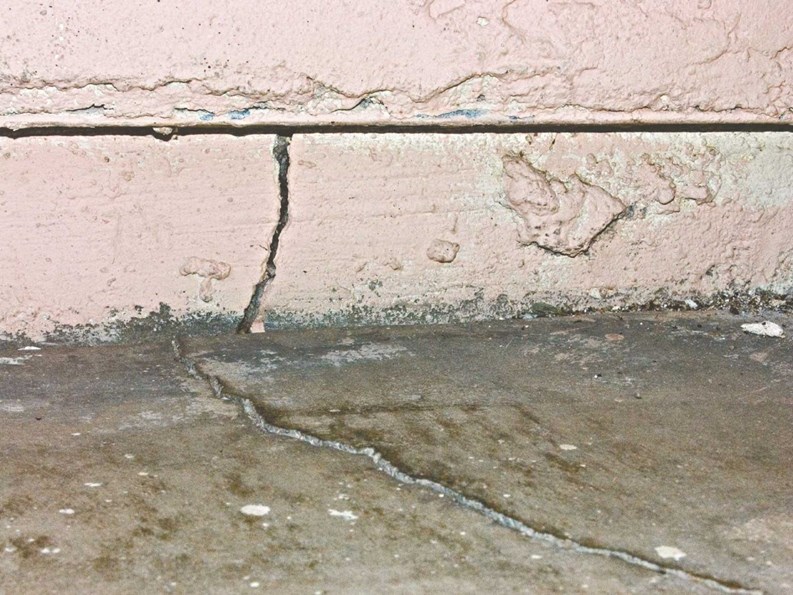They say a house is only as strong as its foundation. A bad roof, or shoddy plumbing can set your building back a lot of money. But, a foundation in disrepair can put the entire building's structure at risk. It can also cost tens of thousands of dollars. Since it's literally underground, it's easy to ignore, and difficult to notice, but the health of a building's foundation is crucial. A little bit of education from the professionals can go a long way to raising anyone's awareness on the importance of a good building's foundation.
Every region has its own architectural history, and New England is no different. “We have old rubble foundations, granite block foundations, there's a little of everything,” says John Luther, building commissioner for the Town of Carlisle in Massachusetts. Often foundations can be one of the best ways to date a house or building, and the New England area has some of the oldest housing stock in the country, and therefore some of most diverse foundation structures.
Not a Rolling Stone
The oldest foundations tend to be made of stone. Builders used to different kinds of mortar as well—in some instances a mud-based one. New England's buildings can also feature brick foundations, and even dry-laid foundations, in which stones were stacked on top of one another with no mortar. Many such constructions did not last long in more precarious terrain, but some parts of New England have allowed old constructions to stay strong. Even now, you can see hand-made construction still intact. Before construction became more machine-based in the twentieth century, every step of home construction was also done by hand, giving builders limited options.
By the 1910s, poured concrete foundations became more common than stone. The different types of construction can lead to different problems. “They're different animals, they're built in different times. It all depends on the code stated at the time of construction,” says Luther. Since condos tend to be newer developments, they almost never contain brick or stone foundations.
Since, modern structures almost exclusively use concrete-based foundations, engineers and property managers have to look out for issues with that in mind. Even though it's a stronger material, concrete foundations face the same enemy as any other foundation: water.
Though some parts of the country can run into foundation issues because the soil is too dry, the Northeast rarely runs into such a problem. Most foundation-related issues have to do with rain and improper drainage. If a building doesn't have a proper drainage system in place, the surrounding soil will erode. “Usually all erosion really starts with water issues, but certainly some soils erode more easily than others,” says Timothy Wentzell, P.E., a principal at Connecticut Property Engineering in South Windsor. “The foundations start being exposed, and there's frost issues, and potentially even more leakage issues,” he says.
Varies by Location
Foundation problems almost always have to do with location. “Connecticut has a fair amount of sandy soils and clay soils. Both of those are little more difficult to compact, especially in the presence of water,” says Wentzell. Before construction of a foundation, inspectors have to make sure that the underlying soil has been properly compacted, so it can effectively anchor the building. A common problem arises when “the materials on the floor may not have been compacted enough—like a garage floor that may develop cracks. When you go in and you tap on it with a metal rod, and hear different sounds in the floor often that means part of the ground wasn't compacted enough,” says Wentzell.
Drainage can be a dangerous issue for foundations in some areas of New England, and for the average resident, the warning signs come very far down the road. “We saw a case where a building's basement floor had about a three-foot void on the descent, and the concrete floor sagged, and we cut a hole in the floor and opened it up, and you could climb in there. There was an underground stream that had slowly over time washed out the entire basement floor,” says Wentzell.
When too much moisture gets into the soil around the foundation, the concrete walls and floor will move with it, which can compromise the safety of the structure. “Part of the building drops,” says Wentzell.
In other areas water and soil settlement pose less of a problem. “Eighty percent of Massachusetts is pretty solid. There are some spots closer to the coast or down in the shore that have some sediments that you don't want to build on, but inland it's just rock,” says Luther. The Massachusetts area tends to have less issues with drainage and settlement, so long as the proper inspections take place. “Once contractors do an excavation, we do an inspection to make sure it's on suitable soil,” Luther.
Inspect, Inspect Some More
Drainage inspections are also an important step. “If you're building correctly, you shouldn't have a problem,” says Luther. But, in parts of Massachusetts, rather than rain runoff, the water table is the greater concern. “Sometimes you get groundwater that comes up, but you shouldn't have gone too far underground. You just check the water tables. It's pretty simple out here,” says Luther.
Concrete, as a material, has some unique qualities. “Concrete gets stronger over a fairly long period over time. You probably see more problems in a 20-year-old building than a 50-year-old building, because the problems in a 50-year-old building have long since been resolved,” “Concrete takes a long time to cure. You may be able to walk on concrete two days after it's poured, but its strength doesn't materialize for a fairly significant period of time. The normal testing is done at seven days and 30 days, but realistically it probably continues to strengthen for the good part of the first year,” says Wentzell
Under the right care, concrete is the most dependable material to go up against nature. “Generally, concrete really shouldn't crack if it's done correctly,” says Wentzell. But, while concrete is the modern choice for any new construction, it's not foolproof. “A lot of things can go wrong when you pour concrete,” he says. Foundation walls will cause problems if the concrete, when it was poured was too dry, too wet, or at a bad temperature. “You can't pour concrete when it's too cold unless you take means to protect it. If it freezes before it cures completely, it'll have a lot cracking and crumbling, you know lots of different issues,” says Wentzell.
Follow the Rules
Generally speaking, a lot of complications can be avoided if contractors and developers simply follow the rules and regulations. When it's a smaller project, corners don't get cut as often because they'd be more obvious, but also because there's less capital and moving parts on the line. “The problems get worse with multifamily housing,” says Wentzell. “The oversight during construction is just a lot poorer. The first unit is often built better than the last unit. Quality control and oversight can be problematic in big projects,” he says.
Before you can build a house you need to start with a solid foundation. Unfortunately, most New Englanders who move into a new condo or building are stuck with whatever foundation that came with it. Still it can be helpful for boards to know that foundations can be a factor in capital projects, and that property managers should be well-versed on the warning signs of foundational trouble.
Tom Lisi is an editorial assistant at New England Condominium and other publications.







Leave a Comment